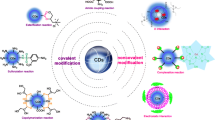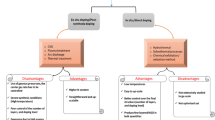Abstract
This work describes the synthesis of a glutathione-capped Cd1-xMgxTe semiconductor nanocrystal alloy in aqueous solution. The effects of reaction time and Cd:Mg molar proportion on the spectroscopic and electrochemical properties were optimized. The Cd1-xMgxTe material was found to emit in the visible range (blueish-green to dark pink), with the band gap energy depending both on the Mg:Cd ratio and of the nanocrystal size. The in-situ growth of the nanocrystal alloy on both graphene oxide and reduced graphene oxide leads to partial quenching of the photoluminescence of Cd1-xMgxTe but improves the electrochemical response of the nanocrystals. Carbon paste electrodes (CPE) were modified with the graphene-based materials containing semiconductor nanocrystals, and it is shown that such a modified CPE can be applied to the determination of the local anesthetic lidocaine and the anaphylactic drug epinephrine via differential pulse voltammetry. Each analyte can be determined both individually and in the presence of constant concentrations of the other, best at typical oxidation potentials of 0.25 V and 1.0 V (vs. Ag/AgCl), respectively. In the best cases, the detection limits are 92 nM for lidocaine and 0.95 μM for epinephrine.

Preparation of glutathione-capped Cd1-xMgxTe nanocrystals was studied in water, followed by growth of the nanocrystal alloy onto graphene. Carbon paste electrodes modified with materials studied were applied to the determination of the local anesthetic lidocaine and epinephrine.




Similar content being viewed by others
References
Smith AM, Nie S (2010) Semiconductor nanocrystals: structure, properties, and band gap engineering. Acc Chem Res 43(2):190–200
Brus LE (1983) A simple model for the ionization potential, electron affinity, and aqueous redox potentials of small semiconductor crystallites. J Chem Phys 79(11):5566–5571
Zhao K, Pan ZX, Zhong XH (2016) Charge recombination control for high efficiency quantum dot sensitized solar cells. J Phys Chem Lett 7(3):406–417
Li SJ, Gao ZD, Shao N (2014) Non-covalent conjugation of CdTe QDs with lysozyme binding DNA for fluorescent sensing of lysozyme in complex biological sample. Talanta 129:86–92
Chen H, Li R, Lin L, Guo G, Lin J-M (2010) A focus on quantum dots for luminescent bioanalysis. Talanta 81:1688–1696
Nascimento CC, Andrade GRS, Neves EC, Barbosa CDES, Costa LP, Barreto LS, Gimenez IF (2012) Nanocomposites of CdS nanocrystals with montmorillonite functionalized with Thiourea derivatives and their use in Photocatalysis. J Phys Chem C 116(41):21992–22000
Tasso M, Singh MK, Giovanelli E, Fragola A, Loriette V, Regairaz M, Dautry F, Treussart F, Lenkei Z, Lequeux N, Pons T (2015) Oriented Bioconjugation of unmodified antibodies to quantum dots capped with Copolymeric ligands as versatile cellular imaging tools. ACS Appl Mater Interf 7(48):26904–26913
Regulacio MD, Han M-Y (2010) Composition tunable alloyed semiconductor nanocrystals. Acc Chem Res 43(5):621–630
Martinez OS, Regalado-Perez E, Mathews NR, Morales ER, Reyes-Coronado D, Galvez GH, Mathew X (2015) Photovoltaic performance of a Cd1-xMgxTe/CdS top-cell structure. Thin Solid Films 582:120–123
Hossain A, Yakimovich V, Bolotnikov AE, Bolton K, Camarda GS, Cui Y, Franc J, Gul R, Kim K-H, Pittman H, Yang G, Herpst R, James RB (2013) Development of cadmium magnesium telluride (Cd1-xMgxTe) for room temperature X- and gamma-ray detectors. J Cryst Growth 379:34–40
Waag A, Heinke H, Scholl S, Becker CR, Landwehr G (1993) Growth of Cd1-xMgxTe thin films by molecular beam epitaxy. J Cryst Growth 13(3–4):607–611
Ihn YS, Kim TJ, Kim YD, Aspnes DE, Kossut J (2004) Optical properties of Cd1-xMgxTe (x=0.00, 0.23, 0.31 and 0.43) thin films. Appl Phys Lett 84(5):693–695
Shin D-H, Kim C-D, Jang H-H, Choe S-H, Kim D-T, Yoon C-S, Kim W-T (1997) Growth and characterization of MgxCd1-xSe single crystals. J Cryst Growth 177(1–2):167–170
Bailey RE, Nie S (2003) Alloyed semiconductor quantum dots: tuning the optical properties without changing the particle size. J Am Chem Soc 125(23):7100–7106
Kruszynska M, Borchert H, Parisi J, Kolny-Olesiak J (2010) Synthesis and shape control of CuInS2 nanoparticles. J Am Chem Soc 132(45):15976–15986
Amelia M, Lincheneau C, Silvi S, Credi A (2012) Electrochemical properties of CdSe and CdTe quantum dots. Chem Soc Rev 41(17):5728–5743
Poznyak SK, Osipovich NP, Shavel A, Talapin DV, Gao M, Eychmuller A, Gaponik N (2005) Size-dependent electrochemical behavior of thiol-capped CdTe nanocrystals in aqueous solution. J Phys Chem B 109(3):1094–1100
Huang H, Zhu J-J (2013) The electrochemical applications of quantum dots. Analyst 138(20):5855–5865
Martin-Garcia B, Polovitsyn A, Prato M, Moreels I (2015) Efficient charge transfer in solution-processed PbS quantum dots-reduced graphene oxide hybrid materials. J Mater Chem C 3(27):7088–7095
Shao Y, Wang J, Wu H, Liu J, Aksay IA, Lin Y (2010) Graphene based electrochemical sensors and biosensors: a review. Electroanalysis 22(10):1027–1036
Cui F, Zhang X (2012) Electrochemical sensor for epinephrine based on glassy carbon electrode modified with graphene/gold nanocomposites. J Electroanal Chem 669:35–41
Sanghavi BJ, Wolfbeis OS, Hirsch T, Swami NS (2015) Nanomaterial-based electrochemical sensing of neurological drugs and neurotransmitters. Microchim Acta 182:1–41
Griend CESVD, Ek AG, Widahl-Nasman ME, Andersson EKM (2006) Method development for the enantiomeric purity determination of low concentrations of adrenaline in local anaesthetic solutions by capillary electrophoresis. J Pharm Biomed Anal 41(1):77–83
Ding M, Zhou Y, Liang X, Zou H, Wang Z, Wang M, Ma J (2016) An electrochemical sensor based on graphene/poly(brilliant cresyl blue) nanocomposite for determination of epinephrine. J Electroanal Chem 763:25–31
Dong Y, Shao J, Chen C, Li H, Wang R, Chi Y, Lin X, Chen G (2012) Blue luminescent graphene quantum dots and graphene oxide prepared by tuning the carbonization degree of citric acid. Carbon 50(12):4738–4743
Grabolle M, Spieles M, Lesnyak V, Gaponik N, Eychmüller A, Resch-Genger U (2009) Determination of the fluorescence quantum yield of quantum dots: suitable procedures and achievable uncertainties. Anal Chem 81(15):6285–6294
Hummers WS Jr, Offeman RE (1958) Preparation of graphitic oxide. J Am Chem Soc 80(6):1339–1339
Wang Q, Fang T, Liu P, Deng B, Min X, Li X (2012) Direct synthesis of high-quality water-soluble CdTe:Zn2+ quantum dots. Inorg Chem 51(17):9208–9213
Markad GB, Battu S, Kapoor S, Haram SH (2013) Interaction between quantum dots of CdTe and reduced graphene oxide: investigation through cyclic voltammetry and spectroscopy. J Phys Chem C 117(40):20944–20950
Beitollahi H, Hamzavi M, Torkzadeh-Mahani M, Shanesaz MA (2015) Novel strategy for simultaneous determination of dopamine and uric acid using a carbon paste electrode modified with CdTe quantum dots. Electroanalysis 27(2):524–533
Santos JC, Matos CRS, Pereira GBS, Santana TBS, Souza HO, Costa LP, Sussuchi EM, Souza AMGP, Gimenez IF (2016) Stable CdTe nanocrystals grown in situ in thiol-modified MCM-41 mesoporous silica: control synthesis and electrochemical detection of Cu2+. Microporous Mesoporous Mater 221:48–57
Wang L, Bai J, Huang P, Wang H, Zhang L (2006) Electrochemical behavior and determination of epinephrine at a Penicillamine self-assembled gold electrode. Int J Electrochem Sci 1(5):238–249
Zhang HM, Zhou XL, Hui RT, Li NQ, Liu DP (2002) Studies of the electrochemical behavior of epinephrine at a homocysteine self-assembled electrode. Talanta 56(6):1081–1088
Oliveira RTS, Banda GRS, Ferreira VS, Oliveira SC, Avaca LA (2007) Electroanalytical determination of lidocaine in pharmaceutical preparations using boron-doped diamond electrodes. Electroanalysis 19(11):1189–1194
Li X (2010) Selective determination of epinephrine in the presence of ascorbic acid and dopamine using a glassy carbon electrode modified with valine. Internat J Chem 2(47):206–211
Shankar SS, Swamy BEK (2014) Detection of epinephrine in presence of serotonin and ascorbic acid by TTAB modified carbon paste electrode: a voltammetric study. Int J Electrochem Sci 9(3):1321–1339
Acknowledgements
Authors are grateful to Brazilian Brazilian funding agencies CNPq, Capes, and Fapitec for financial support, to CMNano-UFS (Proposal #64) for TEM measurements.
Author information
Authors and Affiliations
Corresponding author
Ethics declarations
The author(s) declare that they have no competing interests.
Electronic supplementary material
ESM 1
(DOCX 274 kb)
Rights and permissions
About this article
Cite this article
Matos, C.R.S., Souza, H.O., Santana, T.B.S. et al. Cd1-xMgxTe semiconductor nanocrystal alloys: Synthesis, preparation of nanocomposites with graphene-based materials, and electrochemical detection of lidocaine and epinephrine. Microchim Acta 184, 1755–1764 (2017). https://doi.org/10.1007/s00604-017-2165-8
Received:
Accepted:
Published:
Issue Date:
DOI: https://doi.org/10.1007/s00604-017-2165-8




